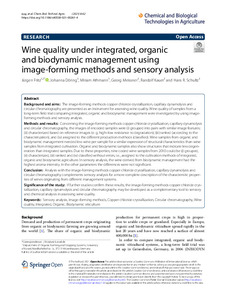| dc.date.accessioned | 2022-04-22T14:43:23Z | |
| dc.date.available | 2022-04-22T14:43:23Z | |
| dc.date.issued | 2021-12-24 | |
| dc.identifier | doi:10.17170/kobra-202204216061 | |
| dc.identifier.uri | http://hdl.handle.net/123456789/13770 | |
| dc.description.sponsorship | Gefördert durch den Publikationsfonds der Universität Kassel | ger |
| dc.language.iso | eng | eng |
| dc.rights | Namensnennung 4.0 International | * |
| dc.rights.uri | http://creativecommons.org/licenses/by/4.0/ | * |
| dc.subject | sensory analysis | eng |
| dc.subject | image-forming methods | eng |
| dc.subject | copper chloride crystallization | eng |
| dc.subject | circular chromatography | eng |
| dc.subject | wine quality | ger |
| dc.subject | integrated | eng |
| dc.subject | organic | eng |
| dc.subject | biodynamic viticulture | eng |
| dc.subject.ddc | 540 | |
| dc.subject.ddc | 600 | |
| dc.subject.ddc | 630 | |
| dc.title | Wine quality under integrated, organic and biodynamic management using image-forming methods and sensory analysis | eng |
| dc.type | Aufsatz | |
| dcterms.abstract | Background and aims
The image-forming methods copper chloride crystallization, capillary dynamolysis and circular chromatography are presented as an instrument for assessing wine quality. Wine quality of samples from a long-term field trial comparing integrated, organic and biodynamic management were investigated by using image-forming methods and sensory analysis.
Methods and results
Concerning the image-forming methods copper chloride crystallization, capillary dynamolysis and circular chromatography, the images of encoded samples were (i) grouped into pairs with similar image features; (ii) characterized based on reference images (e. g. high–low resistance to degradation); (iii) ranked (according to the characterization), and (iv) assigned to the different production methods (classified). Wine samples from organic and biodynamic management needed less wine per sample for a similar expression of structural characteristics than wine samples from integrated cultivation. Organic and biodynamic samples also show structures that indicate less degeneration than integrated samples. Due to these properties, nine coded wine samples from 2010 could be (i) grouped, (ii) characterized, (iii) ranked and (iv) classified without errors, i.e., assigned to the cultivation methods of integrated, organic and biodynamic agriculture. In sensory analysis, the wine derived from biodynamic management had the highest aroma intensity. In the other parameters the differences were not significant.
Conclusion
Analysis with the image-forming methods copper chloride crystallization, capillary dynamolysis and circular chromatography complements sensory analysis for a more complete description of the characteristic properties of wines originating from different management systems.
Significance of the study
If further studies confirm these results, the image-forming methods copper chloride crystallization, capillary dynamolysis and circular chromatography may be developed as a complementary tool to sensory and chemical analysis in assessing wine quality. | eng |
| dcterms.accessRights | open access | |
| dcterms.creator | Fritz, Jürgen | |
| dcterms.creator | Döring, Johanna | |
| dcterms.creator | Athmann, Miriam | |
| dcterms.creator | Meissner, Georg | |
| dcterms.creator | Kauer, Randolf | |
| dcterms.creator | Schultz, Hans Reiner | |
| dc.relation.doi | doi:10.1186/s40538-021-00261-4 | |
| dc.subject.swd | Sensorische Prüfung | ger |
| dc.subject.swd | Wein | ger |
| dc.subject.swd | Lebensmittelqualität | ger |
| dc.subject.swd | Biologisch-dynamische Wirtschaftsweise | ger |
| dc.subject.swd | Messung | ger |
| dc.type.version | publishedVersion | |
| dcterms.source.identifier | eissn:2196-5641 | |
| dcterms.source.journal | Chemical and Biological Technologies in Agriculture | eng |
| dcterms.source.volume | Volume 8 | |
| kup.iskup | false | |
| dcterms.source.articlenumber | 62 | |


